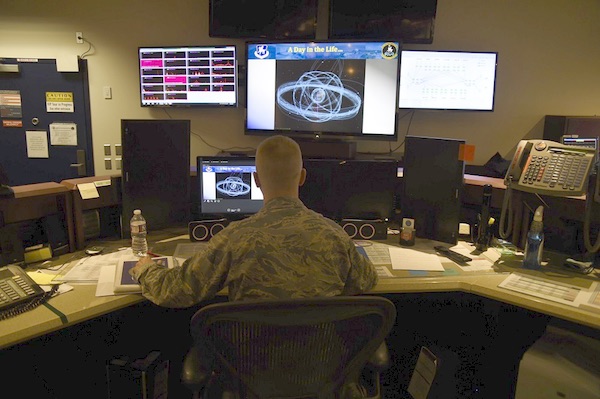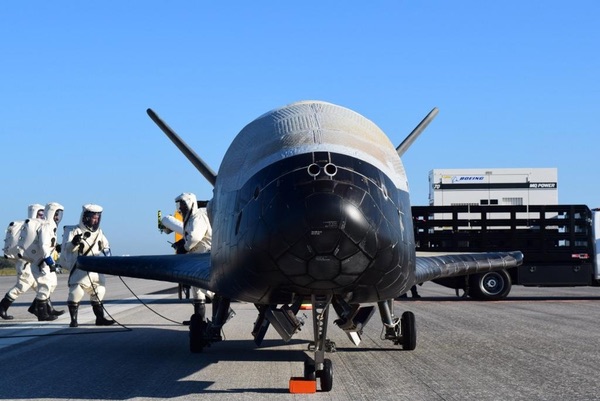It’s time for the US Air Force to prepare for preemption in spaceby Edward G. Ferguson and John J. Klein
|
| Preemption is an offshoot of the inherent right of self-defense, a concept that is largely well understood and is based upon hundreds of years of customary international and treaty law. |
Despite this historic precedence, the United States still has much to do before preemption in space is, in fact, a viable means of protecting national interests. These discussions are especially needed as space grows more contested, degraded, and operationally limited. While being perhaps counterintuitive, developing the concepts of preemption well before conflict occurs enhances deterrence and promotes international peace and stability.
Specifically, America needs a better understanding of what is occurring in space, what constitutes a hostile action or intent, and a fully developed plan for discussing preemption with the international community to make preemption a viable strategic option.
Self-defense and preemption
Preemption is an offshoot of the inherent right of self-defense, a concept that is largely well understood and is based upon hundreds of years of customary international and treaty law. This right pertains to a state being able to defend itself in response to an armed attack.
Article 51 of the Charter of the United Nations recognizes nothing should impair the applicability of a state’s inherent right of self-defense. Similarly, the US Joint Chiefs of Staff’s Standing Rules of Engagement describe the fundamental right of self-defense under the authority and obligation to use all necessary means available to defend US forces—and in certain circumstances property—from a hostile act or demonstrated hostile intent, while taking into account the principles of necessity and proportionality.
In contrast, the legitimacy and practicality of anticipatory self-defense—which occurs before an armed attack or hostile act has actually occurred—is debated among legal scholars (see “China’s new space threat and the justification of US pre-emptive self-defense”, The Space Review, January 18, 2016). Some legal experts take a restrictive interpretation of Article 51 of the UN Charter by stating that the language “armed attack occurs” connotes self-defense only after an attack has begun or happened. Anticipatory or preemptive action would, accordingly, be illegitimate under the Charter.
Yet other legal scholars take a different view, stating the UN Charter’s language does not impair the inherent right of anticipatory self-defense in customary international law under certain conditions.
Unlike treaties, customary international law is not created by what states put down in writing but, rather, by what states do in practice. Secretary of State Daniel Webster’s case writings in 1842 regarding the Caroline diplomatic crisis and Roberto Ago’s legal writings in 1980 similarly conclude preemption is a legitimate action under the conditions of necessity, proportionality and immediacy.
Those conditions mean that there must be a need for military action against an adversary, the response should be proportional given the threat, and that the threat is considered to be of an immediate nature. The decision to act preemptively is a political choice, supported with military capability and justified to the international community.
| Anticipatory self-defense is a viable course of action in space if vital US assets are under imminent threat of armed attack or a hostile act. |
One of the best-known security documents advocating the legitimacy of preemption is the 2002 US National Security Strategy. It is notable in its unabashed consideration of preemptive action, as well as a preventative war, when there is an imminent threat to America. The document states, “The United States has long maintained the option of preemptive actions to counter a sufficient threat to our national security.”
The strategy articulates that the greater the threat, the greater the risk of inaction, thereby justifying anticipatory action to defend US interests, even if uncertainty remains as to the time and place of the enemy’s attack. Therefore, to prevent hostile acts by adversaries, the United States will—if necessary—act preemptively.
Considerations for preemption in space
Considering the wide-array of US national security interests in space and that preemption is widely considered as legitimate under customary international law, anticipatory self-defense is a viable course of action in space if vital US assets are under imminent threat of armed attack or a hostile act.
Preemption in space will need to meet the three preconditions—necessity, proportionality, and immediacy—noted previously. However, while preemption in space should not be considered controversial, space as a domain of warfare presents special challenges for preemptive action.
Specifically, preemption in space necessitates capabilities and processes for “observing” what is occurring, “categorizing” potential threats, and “communicating” understandings with the international community.
Observing
The goal of preemption is to act before an adversary, to mitigate or minimize a threat before negative consequences are realized. Acting inside an adversary’s decision cycle—or orient, observe, decide and act (OODA) loop—is a long taught concept within the US Department of Defense. US Air Force Col. John Boyd developed his OODA loop theory during the Korean War, in the belief that an ability to observe, orient, decide, and act faster than an adversary was the key to victory.
Preemptive action is also aimed at acting faster than an adversary to achieve one’s objectives and, therefore, supports the OODA loop concept.
The United States, however, lacks the requisite ability to operate within an adversary’s OODA loop in space and, therefore, cannot optimally execute anticipatory self-defense. Consequently, the United States needs to tighten its OODA loop in order to meet the threats it faces in space.
Today, the Joint Space Operations Center has a limited ability to understand the impact or significance of what satellites are doing. The current capability is more akin to “space surveillance and tracking” rather than on-orbit “situational awareness.” Furthermore, while the Space Fence will increase America’s ability to identify objects on-orbit, just knowing something is in space is not enough to support the decision loop. A comprehensive, real-time situational awareness capability is required in order to orient and act within the space environment.
Some things, like the newly renamed National Space Defense Center and civil space traffic management proposals by the FAA, are well are on their way to improving awareness, while others, like how the US Defense Department will organize to share threat information are not (see “America needs a space corps”, The Space Review, March 13, 2017).
Categorizing
The decision to act preemptively is ultimately a political decision, informed by the magnitude and manner in which US assets are being threatened. Without such an informed decision, preemption is merely aggression. With the growing number of threats to US space interests deployed today, the decision on what action to take to protect America’s space capabilities is becoming more urgent.
| The range of potential offensive acts to critical space systems has contributed to confusion on what types of imminent armed attack or hostile acts rise to the occasion to warrant preemption. |
The requisite information helps determine whether the military necessity precondition is met; a concept that requires a general understanding of what constitutes an “armed attack” (UN Charter Article 51 language), “threat or use of force” (UN Charter Article 2(4) language), or “hostile act or demonstrated hostile intent” (US Joint Chiefs of Staff Standing Rules of Engagement language). While the previous terminologies have similarities, each has a slightly different context and meaning. At times, these differences have resulted in ambiguity in when self-defense, let alone preemption, in space warfare is considered consistent with either customary international law or treaty law.
Another challenge for preemption in space is a result of the broad range of possible actions in space. This includes activities ranging from reversible (jamming) to non-reversible (destroying critical satellite electronics), and includes kinetic or non-kinetic actions, such as an anti-satellite missile or a laser. This range of potential offensive acts to critical space systems has contributed to confusion on what types of imminent armed attack or hostile acts rise to the occasion to warrant preemption.
Some strategists may question whether non-kinetic and reversible actions necessitate a military response. For these reasons, clarity is needed in US joint doctrine, as well as Standing and Supplemental Rules of Engagement, regarding the conditions justifying self-defense and informing a decision for preemptive action in space.
Communicating
The final consideration in weighing preemptive action is communicating. The US policy regarding preemption, with its emphasis on the legal basis for preemption and how armed attack and hostile acts in space are considered, needs to be shared among the international community. Such dialogue with allies and partners will lessen any misunderstanding or uncertainty during a war extending into space.
By communicating what types of situations will meet necessity, proportionality and immediacy—considerations for preemptive action—the United States will be better able to garner international support for potential coalitions to address emerging threats.
Moreover, the United States needs to take a leadership role among the international community and commercial space operators in discussing and refining what constitutes norms of behavior and standard business practices in space.
While the United States supports bilateral, multilateral, and international transparency and confidence building measures, more work needs to be done discussing and understanding the current norms of behavior and day-to-day business practices of commercial space operators. Such discussions hold promise in better defining actions that display hostile intent, as well as acts that meet immediacy criteria. This understanding will better inform a decision for preemptive action.
 Logos for US Air Force Space Aggressors, who replicate potential foes in space. (credit: US Air Force) |
Counterargument
History is replete with preemptive action that did not positively affect the outcome of the conflict. Pearl Harbor did not give Japan the advantage it needed to secure its territorial gains in World War II. The U.S.-led invasion of Iraq in 2003—which some consider a preventative war—did not result in the discovery of a large-scale weapons of mass destruction program assessed to be there.
While only being two examples of failed preemption, some critics might conclude preemptive action is not worth the associated cost and therefore should be eliminated from the strategic toolkit.
The counter-argument is that strategy is pursued to place one in a position of advantage for what comes next. When a state preempts, it makes a choice between receiving the first blow or striking first. Preemption is not a decision whether to go to war or not, it is about the terms under which the conflict will occur. Deciding against preemption when certain hostile action is imminent is unlikely to improve one’s military position, because the situation dictates that the decision for war has already been made.
If the attack is certain, there are only two reasons for withholding the use of preemptive force. First, it may not be feasible to preempt, because one’s OODA loop is not adequate. Second, it may be judged politically important to allow the enemy to attack first, thereby branding himself unquestionably as the aggressor. In the end, however, whether preemptive action is taken or not should not dissuade the United States from pursing the recommendations outlined above, because they are needed during the conduct of conflict anyway.
 A US Air Force Space Operations mission commander oversees satellite control network antennas from Colorado. (credit: US Air Force) |
The way ahead
Because the United States has significant national interests in space and may have the most to lose in a war in space, preemptive action should be considered as a military option. Customary international law has long supported the view that a state can attack first in a proportional manner, when under imminent threat of armed attack or hostile act.
| Even though space is a domain of potential warfare—like the land, sea, and air—strategic space concepts like preemption are not fully developed commensurate with these other domains. There is no excuse for this situation. |
But despite the view that preemption is consistent with customary international law, more work needs to occur before the US can, in fact, successfully employ preemptive action, even though notable work has been initiated.
Improving space situation awareness capabilities, clarifying armed attack and hostile act definitions, and communicating with the international community the criteria for preemption in space should all be further advanced and discussed. Additionally, the longer national security space organizational issues plague the US Defense Department, the longer it will be until America will have the capability to operate inside an adversary’s OODA loop.
More dialogue and debate in these areas should be welcomed among the security and policy communities, even if it results in the view that the United States presently lacks the requisite capabilities and processes.
US space capabilities need to be able to respond at any point in a space conflict timeline and at any location, whether preemptively or after being attacked. Such capabilities help ensure the highest probability to retain the choice to act preemptively. Without a full spectrum of space domain options, the United States is forced to address every problem with limited options.
As Abraham Maslow popularized in 1966, if you only have a hammer, it is tempting to treat everything like a nail. Preemptive actions can and should be tailored as the situation dictates, without unjustified limitations.
Final thoughts
Even though space is a domain of potential warfare—like the land, sea, and air—strategic space concepts like preemption are not fully developed commensurate with these other domains. There is no excuse for this situation. Capabilities that enable anticipatory self-defense actions enhance strategies to prevent conflict.
Potential adversaries believing America has a quicker OODA loop for on-orbit activities, an understanding of what constitutes an armed attack and hostile act, and a long-term effort to communicate when preemptive action is justified may decide not to seek direct confrontation with the United States, or its allies and partners.
These benefits are especially helpful when confronted with potential adversaries who have military strategies of escalate to de-escalate, or those viewing compellence through military action as a part of overall deterrence. A credible and potentially overwhelming preemptive action that is necessary and proportional contributes to comprehensive deterrence through punishment and denial strategies.
